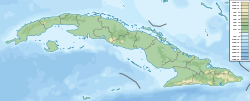| Guasasa Formation | |
|---|---|
| Stratigraphic range: Tithonian-Early Valanginian ~ | |
| Type | Formation |
| Sub-units | San Vicente, El Americano, Tumbadero & Tumbitas Members |
| Overlies | Jagua Formation |
| Lithology | |
| Primary | Limestone |
| Other | Shale, dolomite, chert |
| Location | |
| Coordinates | 22°42′N83°48′W / 22.7°N 83.8°W |
| Approximate paleocoordinates | 5°54′N53°00′W / 5.9°N 53.0°W |
| Region | Pinar del Río Province |
| Country | Cuba |
| Extent | Sierra de los Órganos |
| Type section | |
| Named for | Guasasa |
The Guasasa Formation is a geologic formation in Cuba. It is Tithonian to Early Valanginian in age and contains fossils of ammonites. [1]
